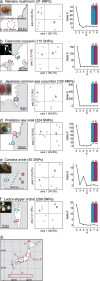MIG-seq: an effective PCR-based method for genome-wide single-nucleotide polymorphism genotyping using the next-generation sequencing platform
- PMID: 26593239
- PMCID: PMC4655332
- DOI: 10.1038/srep16963
MIG-seq: an effective PCR-based method for genome-wide single-nucleotide polymorphism genotyping using the next-generation sequencing platform
Abstract
Restriction-enzyme (RE)-based next-generation sequencing methods have revolutionized marker-assisted genetic studies; however, the use of REs has limited their widespread adoption, especially in field samples with low-quality DNA and/or small quantities of DNA. Here, we developed a PCR-based procedure to construct reduced representation libraries without RE digestion steps, representing de novo single-nucleotide polymorphism discovery, and its genotyping using next-generation sequencing. Using multiplexed inter-simple sequence repeat (ISSR) primers, thousands of genome-wide regions were amplified effectively from a wide variety of genomes, without prior genetic information. We demonstrated: 1) Mendelian gametic segregation of the discovered variants; 2) reproducibility of genotyping by checking its applicability for individual identification; and 3) applicability in a wide variety of species by checking standard population genetic analysis. This approach, called multiplexed ISSR genotyping by sequencing, should be applicable to many marker-assisted genetic studies with a wide range of DNA qualities and quantities.
Figures



Similar articles
-
Multiplexed ISSR Genotyping by Sequencing (MIG-Seq).Methods Mol Biol. 2023;2638:403-414. doi: 10.1007/978-1-0716-3024-2_29. Methods Mol Biol. 2023. PMID: 36781659
-
Simple SNP-based minimal marker genotyping for Humulus lupulus L. identification and variety validation.BMC Res Notes. 2015 Oct 6;8:542. doi: 10.1186/s13104-015-1492-2. BMC Res Notes. 2015. PMID: 26438052 Free PMC article.
-
Finding the right coverage: the impact of coverage and sequence quality on single nucleotide polymorphism genotyping error rates.Mol Ecol Resour. 2016 Jul;16(4):966-78. doi: 10.1111/1755-0998.12519. Epub 2016 Mar 25. Mol Ecol Resour. 2016. PMID: 26946083
-
Efficient genome-wide genotyping strategies and data integration in crop plants.Theor Appl Genet. 2018 Mar;131(3):499-511. doi: 10.1007/s00122-018-3056-z. Epub 2018 Jan 19. Theor Appl Genet. 2018. PMID: 29352324 Review.
-
QTL mapping using high-throughput sequencing.Methods Mol Biol. 2015;1284:257-85. doi: 10.1007/978-1-4939-2444-8_13. Methods Mol Biol. 2015. PMID: 25757777 Review.
Cited by
-
Double migration of the endangered Tricyrtis formosana (Liliaceae) in Japan.Sci Rep. 2024 Jan 10;14(1):957. doi: 10.1038/s41598-024-51431-x. Sci Rep. 2024. PMID: 38200076 Free PMC article.
-
Habitat diversification associated with urban development has a little effect on genetic structure in the annual native plant Commelina communis in an East Asian megacity.Ecol Evol. 2024 Feb 21;14(2):e10975. doi: 10.1002/ece3.10975. eCollection 2024 Feb. Ecol Evol. 2024. PMID: 38384819 Free PMC article.
-
Genetic diversification of allohexaploid Brassica hybrids (AABBCC) using a fertile octoploid with excessive C genome set (AABBCCCC).Planta. 2024 Aug 13;260(3):71. doi: 10.1007/s00425-024-04497-w. Planta. 2024. PMID: 39136783
-
Detection of reproductive interference between closely related Salvia species with small-scale separated distributions by multifaceted pollination and molecular analyses.J Plant Res. 2024 Nov;137(6):1033-1047. doi: 10.1007/s10265-024-01577-6. Epub 2024 Aug 30. J Plant Res. 2024. PMID: 39214907 Free PMC article.
-
A new species of Quercus genus (Fagaceae) from Son Tra Peninsula, Central Vietnam.PhytoKeys. 2022 Aug 26;206:61-73. doi: 10.3897/phytokeys.206.85635. eCollection 2022. PhytoKeys. 2022. PMID: 36761265 Free PMC article.
References
-
- Davey J. W. et al. Genome-wide genetic marker discovery and genotyping using next-generation sequencing. Nat. Rev. Genet. 12, 499–510 (2011). - PubMed
-
- Altshuler D. et al. An SNP map of the human genome generated by reduced representation shotgun sequencing. Nature 407, 513–516 (2000). - PubMed
-
- Van Tassell C. P. et al. SNP discovery and allele frequency estimation by deep sequencing of reduced representation libraries. Nat. Methods 5, 247–252 (2008). - PubMed
Publication types
MeSH terms
Substances
LinkOut - more resources
Full Text Sources
Other Literature Sources
Research Materials
Miscellaneous

